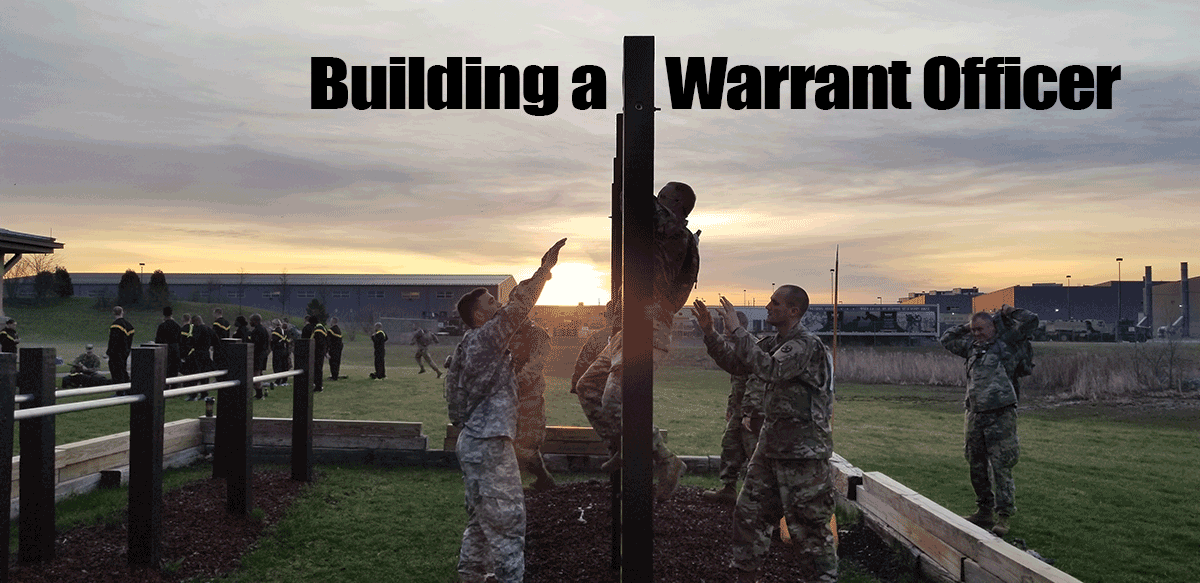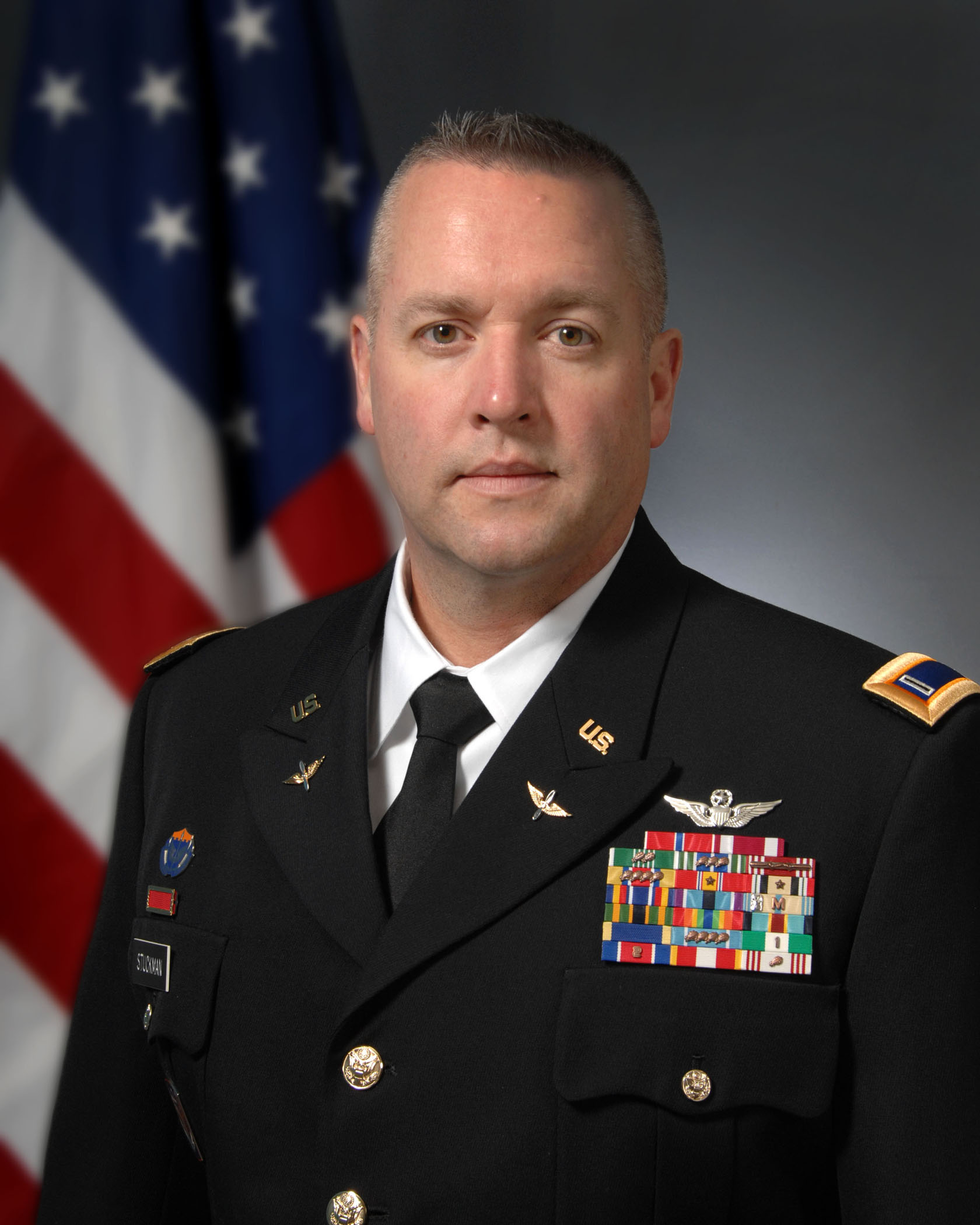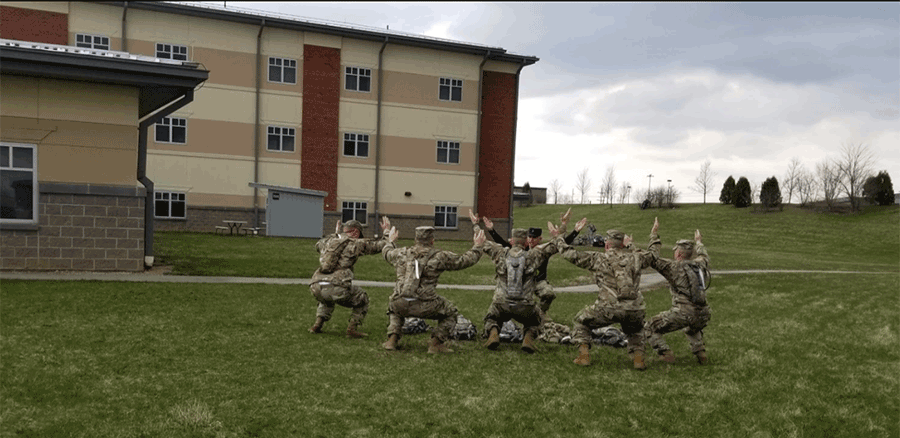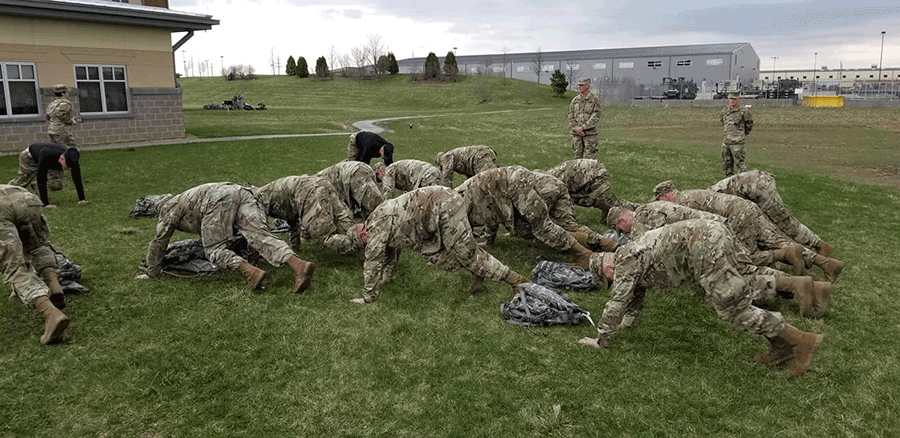
Building a Warrant Officer:
Ohio’s Reserve Component Warrant Officer Candidate School
By Chief Warrant Officer 5 Jay K. Stuckman, State Command Chief Warrant Officer

Ohio National Guard photos
Students in the Reserve Component-Warrant Officer Candidate School participate in physical readiness training at the 147th Regiment (Regional Training Institute), located at Defense Supply Center Columbus in Columbus, Ohio. The RC-WOCS program allows Reserve and National Guard Soldiers a flexible opportunity to complete the necessary training to become U.S. Army warrant officers, enabling them to serve as technical experts, combat leaders, trainers and advisors.
Unbeknownst to most of the Ohio Army National Guard, there is a small group honing their skills in hopes of joining an exclusive cohort. The warrant officer candidates of Class 19-001 are training to become the technical experts, combat leaders, trainers and advisors of Ohio’s future. If the candidates successfully complete Reserve Component-Warrant Officer Candidate School, they will join the 133 other warrant officers to have graduated from Ohio’s RC-WOCS program, since its beginning in 2006. They will become the newest members of an elite group that comprises only 2% of the OHARNG.
Prior to attending WOCS, each candidate was individually selected by their respective Army proponent, met strict medical requirements for commissioning and completed a formal, in-person federal recognition board. The candidates of Class 19-001 are certainly no strangers to the Army. Historically, the typical Ohio WOCS candidate is a staff sergeant, 35 years old, with 15 years’ time-in-service. Their experience is their strength; the candidates will rely on their years of experience during the next several months.
Unlike their commissioned officer counterparts, warrant officers don’t have a direct commissioning process; their appointment must be earned. The RC-WOCS program allows Reserve and National Guard Soldiers a flexible opportunity to complete the necessary training, while still meeting the same high standards outlined by the U.S .Army’s Warrant Officer Career College at Fort Rucker, Alabama. RC-WOCS is composed of three distinct phases — Phases 1 and 2 are conducted at the 147th Regiment (Regional Training Institute), located at Defense Supply Center Columbus in Columbus, Ohio. Phase 3 is conducted at the 138th Regiment (RTI), Camp Atterbury, Indiana.
Phase 1 is an optional (but highly recommended) orientation phase offered in February and March. Candidates receive mentorship from previous WOCS graduates and begin learning the RC-WOCS course standards. Most importantly, they begin networking with colleagues that they will turn to throughout the rest of their careers. By evaluating each other’s strengths and expertise, they can better prepare for the challenges of the coming months.
Phase 2 is conducted via MUTA 5 (2½ days) Inactive Duty Training weekends, from April through August. In order to begin Phase 2, candidates must meet height/weight requirements, pass an Army Physical Fitness Test and complete any required distance learning. This phase is a high-stress, detail-oriented, action-packed stage in each candidate’s development. Training, Advising and Counseling (TAC) officers, Chief Warrant Officer 3 James Camechis and Chief Warrant Officer 2 Brian Watercutter, provide pinpointed leadership evaluation and mentorship for the WOCs. The TAC officers operate under the command of Chief Warrant Officer 3 John Metzler, Ohio’s RC-WOCS commander and senior instructor. TAC officers stress the fundamentals of officer leadership; they also mentally and physically challenge each candidate to operate at their full potential, with an emphasis on teamwork and leadership evaluation.
The Phase 2 training schedule is primarily filled with academic courses, taught by volunteer instructors from around the state. The academic material is tested during two exams, which must be passed to continue the course. Major training events include a community outreach project, a military briefing presentation and a timed 10-kilometer foot march. The rest of the training schedule contains daily physical readiness training (PRT), small group instruction, operational environment analysis and staff exercises.
Phase 2 of WOCS is more than just time spent at drill. The IDT weekends are an execution of the planning and communication that the candidates accomplish between drills. The candidates have additional duty positions and projects that will require their attention throughout the month. Each class provides its own staff, with candidates acting as the primary or alternate for all staff and additional duty positions. Each weekend, they brief the WOCS commander on their respective position/project. Candidates have their leadership evaluated during their time as the candidate class leader, candidate class sergeant, and/or candidate squad leader. Phase 2 concludes with an additional weekend in August to prepare the WOCs for land navigation and leader reaction courses in the next phase.
Phase 3 is a two-week culminating exercise conducted at Camp Atterbury, Indiana. This final phase is a collective training event for multiple RC-WOCS programs; 150-200 candidates join together to form two company-size elements. Ohio’s candidates will have an opportunity to network and learn from candidates hailing from all over the country; candidates from over 40 U.S. states and territories have completed their RC-WOCS training in Indiana. Candidates will conduct additional academic coursework, leadership evaluations and daily PRT. Major training events include a formal staff exercise, land navigation, leader reaction course and a field training exercise. Phase 3 concludes with a class reception and a graduation ceremony in nearby Franklin, Indiana.
Following WOCS graduation, the newly-appointed warrant officers (WO1s) will go on to complete the Warrant Officer Basic Course (WOBC), which varies in length depending on the individual’s occupational specialty. WOBC courses are held at various installations throughout the country, and last from several weeks to several months. After graduating WOBC, WO1s are evaluated as duty-qualified “company-grade” officers, but they will hold positions at all echelons within the Ohio Army National Guard.
Ohio National Guard photos
For more information on how to become a member of Ohio’s elite cohort, please contact the OHARNG warrant officer strength managers, Chief Warrant Officer 2 Deena Ratliff (614-376-5054) or Warrant Officer Autumn Peters (614-376-5277). Even if you don’t currently qualify, they can work to put you on the path to success.

By Chief Warrant Officer 5 Jay K. Stuckman
Chief Warrant Officer 5 Jay Stuckman enlisted in the Ohio Army National Guard in March 1985 and completed basic combat training at Fort Knox, Kentucky in August 1985, between his junior and senior years of high school. His enlisted service includes assignments as a combat signaler, recruiter’s aide and personnel record clerk, prior to his appointment as a warrant officer in 1993. He is rated as a master Army aviator with more than 3,300 flight hours in the UH-1 Iroquois and the UH-60 Black Hawk. Stuckman flew 136 combat missions while deployed to Iraq in 2009, logging more than 550 combat flight hours in the UH-60. He became the state command chief warrant officer in June 2012, and is responsible for overseeing warrant officer leader development and mentorship while providing essential advice to the assistant adjutant general for Army on warrant officer issues.

